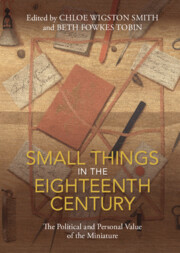Book contents
- Small Things in the Eighteenth Century
- Small Things in the Eighteenth Century
- Copyright page
- Contents
- Figures
- Notes on Contributors
- Acknowledgments
- Introduction
- Part I Reading Small Things
- 1 “The Sum of All in All”
- 2 Nuts, Flies, Thimbles, and Thumbs
- 3 Gothic Syntax
- 4 Small, Familiar Things on Trial and on Stage
- Part II Small Things in Time and Space
- Part III Small Things at Hand
- Part IV Small Things on the Move
- Afterword
- Select Bibliography
- Index
3 - Gothic Syntax
from Part I - Reading Small Things
Published online by Cambridge University Press: 29 September 2022
- Small Things in the Eighteenth Century
- Small Things in the Eighteenth Century
- Copyright page
- Contents
- Figures
- Notes on Contributors
- Acknowledgments
- Introduction
- Part I Reading Small Things
- 1 “The Sum of All in All”
- 2 Nuts, Flies, Thimbles, and Thumbs
- 3 Gothic Syntax
- 4 Small, Familiar Things on Trial and on Stage
- Part II Small Things in Time and Space
- Part III Small Things at Hand
- Part IV Small Things on the Move
- Afterword
- Select Bibliography
- Index
Summary
Horace Walpole finishes his account of writing The Castle of Otranto (1764) with a wry look at its syntactics, confessing that late one night he “could not hold the pen to finish the sentence, but left Matilda and Isabella talking, in the middle of a paragraph.” A close look at the beginnings, middles, and ends not only of chapters but also of paragraphs and even sentences in this first gothic novel reveals syntactical passages behaving like subterranean passages. As readers, we often don’t know what’s coming until we turn the corner of the sentence and bump into it. The lack of quotation marks to distinguish dialogue (when quotation marks were entering into common use) repeatedly slides the reader down wrong turns; we mistake one speaker for another. Later editions would insert quotation marks, brightly lighting the syntactic interior. But what Walpole initiates for the gothic on the small level of typography and syntax as well as of atmosphere and plot is precisely the uneasiness of boundaries obscured and identities blurred. This chapter tracks the spatial implications of the shapes of sentences and the peculiarities of paragraphs in The Castle of Otranto to uncover a template of syntactical structures enacting gothic structures.
Keywords
- Type
- Chapter
- Information
- Small Things in the Eighteenth CenturyThe Political and Personal Value of the Miniature, pp. 47 - 63Publisher: Cambridge University PressPrint publication year: 2022

